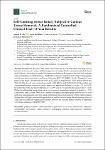Self-Limiting versus Rotary Subjective Carious Tissue Removal: A Randomized Controlled Clinical Trial—2-Year Results
| dc.contributor.author | Ali, AH | |
| dc.contributor.author | Thani, FB | |
| dc.contributor.author | Foschi, Federico | |
| dc.contributor.author | Banerjee, A | |
| dc.contributor.author | Mannocci, F | |
| dc.date.accessioned | 2023-05-05T12:08:25Z | |
| dc.date.available | 2023-05-05T12:08:25Z | |
| dc.date.issued | 2020-09 | |
| dc.identifier.issn | 2077-0383 | |
| dc.identifier.issn | 2077-0383 | |
| dc.identifier.other | 2738 | |
| dc.identifier.uri | https://pearl.plymouth.ac.uk/handle/10026.1/20831 | |
| dc.description.abstract |
Background: the aim of this study was to assess the 2-year pulp survival of deep carious lesions in teeth excavated using a self-limiting protocol in a single-blind randomized controlled clinical trial. Methods: At baseline, 101 teeth with deep carious lesions in 86 patients were excavated randomly using self-limiting or control protocols. Standardized clinical examination and periapical radiographs of teeth were performed after 1- and 2-year follow-ups (REC 14/LO/0880). Results: During the 2-year period of the study, 24 teeth failed (16 and 8 at T12 and T24, respectively). Final analysis shows that 39/63 (61.9%) of teeth were deemed successful (16/33 (48.4%) and 23/30 (76.6%) in the control and experimental groups, respectively with a statistically significant difference (z score = 2.3, p = 0.021). Of teeth with severe and mild symptoms at T0, 42.9% and 36.7% respectively failed at T24 (p > 0.05). Within the self-limiting group, there was a lower success in premolars compared to molars (p < 0.05). Conclusion: after 2 years, there was a statistically significant higher pulp survival rate of teeth with deep carious lesions excavated using self-limiting protocols in patients with reversible pulpitis. Molars showed higher success than premolars in teeth excavated using the self-limiting protocol. There was no statistically significant association between the outcome and the severity of symptoms at T0 (ClinicalTrials.gov NCT03071588). | |
| dc.format.extent | 2738-2738 | |
| dc.format.medium | Electronic | |
| dc.language | en | |
| dc.publisher | MDPI AG | |
| dc.subject | pulpitis | |
| dc.subject | Carisolv | |
| dc.subject | chemomechanical gel | |
| dc.subject | rotary excavation | |
| dc.subject | clinical trial | |
| dc.subject | computed tomography | |
| dc.subject | microscopy | |
| dc.subject | caries | |
| dc.subject | periapical radiograph | |
| dc.subject | selective caries removal | |
| dc.subject | minimally invasive dentistry | |
| dc.title | Self-Limiting versus Rotary Subjective Carious Tissue Removal: A Randomized Controlled Clinical Trial—2-Year Results | |
| dc.type | journal-article | |
| dc.type | Journal Article | |
| plymouth.author-url | https://www.webofscience.com/api/gateway?GWVersion=2&SrcApp=PARTNER_APP&SrcAuth=LinksAMR&KeyUT=WOS:000580282900001&DestLinkType=FullRecord&DestApp=ALL_WOS&UsrCustomerID=11bb513d99f797142bcfeffcc58ea008 | |
| plymouth.issue | 9 | |
| plymouth.volume | 9 | |
| plymouth.publication-status | Published online | |
| plymouth.journal | Journal of Clinical Medicine | |
| dc.identifier.doi | 10.3390/jcm9092738 | |
| plymouth.organisational-group | |Plymouth | |
| plymouth.organisational-group | |Plymouth|Faculty of Health | |
| plymouth.organisational-group | |Plymouth|Users by role | |
| plymouth.organisational-group | |Plymouth|Users by role|Academics | |
| plymouth.organisational-group | |Plymouth|Faculty of Health|Peninsula Dental School | |
| dc.publisher.place | Switzerland | |
| dcterms.dateAccepted | 2020-08-18 | |
| dc.date.updated | 2023-05-05T12:08:07Z | |
| dc.rights.embargodate | 2023-8-16 | |
| dc.identifier.eissn | 2077-0383 | |
| dc.rights.embargoperiod | forever | |
| rioxxterms.versionofrecord | 10.3390/jcm9092738 |


